Papers by André Botequilha-Leitão
Journal of the American Planning Association, 2008
Page 1. MEASURING LANDSCAPES A Planner's Handbook André Botequila Leitão, Joseph Miller, Jac... more Page 1. MEASURING LANDSCAPES A Planner's Handbook André Botequila Leitão, Joseph Miller, Jack Ahern, and Kevin McGarigal Page 2. Page 3. About Island Press Island Press is the only nonprofit organization in the United ...
Tourism & Management Studies, Jan 31, 2018
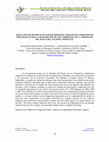
Las herramientas propias de la Ecología del Paisaje son un instrumento ampliamente utilizado en e... more Las herramientas propias de la Ecología del Paisaje son un instrumento ampliamente utilizado en el análisis de la estructura de los paisajes para cuantificar sus características espaciales y las relaciones con los procesos territoriales. Sin embargo, el amplio número de métricas disponibles y el grado de correlación existente entre ellas han generado la necesidad de seleccionar conjuntos reducidos, adecuados para su aplicación en diferentes contextos y paisajes. Este artículo presenta la selección de un conjunto de estas métricas para una de las regiones más dinámicas de Portugal, como el Algarve, mediante un análisis de componentes principales y empleando para ello la cartografía del proyecto Corine Land Cover para tres fechas CLC 1990 (imágenes de 1985), 2000 y 2006. Los resultados del análisis han permitido determinar tres componentes principales presentes en las tres fechas seleccionadas, asociados con el área de las teselas y la forma de aquellas de mayor tamaño, y, en menor me...

Applied Geography, 2014
ABSTRACT The importance of urban growth processes and their spatial characteristics has led to a ... more ABSTRACT The importance of urban growth processes and their spatial characteristics has led to a growing interest in monitoring these phenomena. Spatial metrics are widely employed for this purpose, appearing in an increasing number of studies where they are used to characterise growth patterns and their evolution over time. This paper presents an analysis of urban growth patterns using spatial metrics in the Algarve (southern Portugal), an area of considerable urban dynamics associated with tourism. Two datasets were used (CORINE 1:100,000 maps and COS 1:25,000 maps) and two time periods (1990 and 2006e2007) in order to compare the different urban land use patterns detected and their evolution over time. The results show differences in urban land use patterns and associated processes at each scale, with stable land use patterns predominating at the 1:100,000 scale whereas the 1:25,000 scale showed a move towards more dispersed patterns. These results have enabled an assessment of the principal differences in urban growth patterns observed at both scales, and the implications for planning these entail
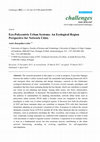
The research presented in this paper is a work in progress. It provides linkages between the auth... more The research presented in this paper is a work in progress. It provides linkages between the author's earlier research under the sustainable land planning framework (SLP) and emergent ideas and planning and design strategies, centered on the (landscape) ecological dimension of cities' sustainability. It reviews several concepts, paradigms, and metaphors that have been emerging during the last decade, which can contribute to expand our vision on city planning and design. Among other issues, city form-monocentric, polycentric, and diffused-is discussed. The hypothesis set forth is that cities can improve the pathway to sustainability by adopting intermediate, network urban forms such as polycentric urban systems (PUS) under a broader vision (as compared to the current paradigm), to make way to urban ecological regions. It discusses how both the principles of SLP and those emergent ideas can contribute to integrate PUS with their functional hinterland, adopting an ecosystemic viewpoint of cities. It proposes to redirect the current dominant economic focus of PUS to include all of the other functions that are essential to urbanites, such as production (including the 3Rs), recreation, and ecology in a balanced way. Landscape ecology principles are combined with complexity science in order to deal with uncertainty to improve regional systems' resilience. Cooperation in its multiple forms is seen as a fundamental social, but also economic process contributing to the urban network functioning, including its evolving capabilities for self-organization and adaptation.
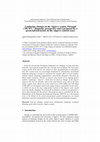
In the last two decades Portuguese landscapes are changing, in some parts dra- matically, and reg... more In the last two decades Portuguese landscapes are changing, in some parts dra- matically, and regional asymmetries have become more profound. The rural land- scapes, mostly in the interior, are subject to either marginalization or intensifica- tion. The coastal areas are increasingly dominated by urbanization. Sustainable landscape planning is needed to counteract the negative effects of such transfor- mations, namely landscape fragmentation, and provide alternative directions for future urban expansion. Hereby we present some results of an ongoing project entitled "Landscape - Algarve", which focus on land use changes in the Algarve region in the last two decades, both in the rural interior areas and in the more urban, coastal areas. Based on Corine Land Cover (1985-2006) and COS Maps (1990-2007) we developed a multi-scale spatial analysis, and build a trend scenar- io (2025) for one of the most compromised sections of the Algarve coast, mostly rural but rapidly changing....
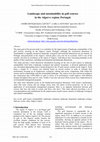
The main goal of the present study is to contribute for the improvement of landscape sustainabili... more The main goal of the present study is to contribute for the improvement of landscape sustainability of the golf activity, focusing on the Algarve region, Portugal. Although the economical dimension of sustainability is arguably assured its landscape, ecological and territorial dimensions are not entirely. In Portugal, and particularly in the Algarve, tourism plays a key role for its economy. Golf is one of the touristic activities by excellence in the region of Algarve. Golf players have increasing demands on the quality of their experience, including environmental and landscape dimensions. This study provides a brief theoretical introduction focusing on the role of golf courses in landscape sustainability from both a landscape ecological and cultural viewpoints. A practical application study was developed approaching from a broad perspective the 39 golf courses existent in the Algarve. From these a sample of 13 courses was selected based on several criteria, in order to estimate th...

Las herramientas propias de la Ecologia del Paisaje son un instrumento ampliamente utilizado en e... more Las herramientas propias de la Ecologia del Paisaje son un instrumento ampliamente utilizado en el analisis de la estructura de los paisajes para cuantificar sus caracteristicas espaciales y las relaciones con los procesos territoriales. Sin embargo, el amplio numero de metricas disponibles y el grado de correlacion existente entre ellas han generado la necesidad de seleccionar conjuntos reducidos, adecuados para su aplicacion en diferentes contextos y paisajes. Este articulo presenta la seleccion de un conjunto de estas metricas para una de las regiones mas dinamicas de Portugal, como el Algarve, mediante un analisis de componentes principales y empleando para ello la cartografia del proyecto Corine Land Cover para tres fechas CLC 1990 (imagenes de 1985), 2000 y 2006. Los resultados del analisis han permitido determinar tres componentes principales presentes en las tres fechas seleccionadas, asociados con el area de las teselas y la forma de aquellas de mayor tamano, y, en menor me...
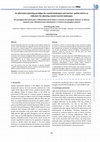
Coastal urbanization dynamics in the Algarve are intimately related with tourism, which dominates... more Coastal urbanization dynamics in the Algarve are intimately related with tourism, which dominates the regional economy. We present part of the results of a research project in the coastal landscapes of Algarve, focusing on land use and land change, particularly urban sprawl around Faro, one of the highest concentrations of tourism resorts in the region. We performed a diachronic analysis (1990-2000) based on Corine Land Cover data. We combined contingence tables and landscape metrics. A parsimonious suite of these spatial metrics were selected in order to be easily combined as to derive results with a straightforward interpretation, and moving windows technique facilitated the task in identifying gradients of landscape heterogeneity. Land use planning must pay more attention to tourism, adopting combined spatial approaches, monitor initiatives, and do better plans. Metrics are good indicators for this purpose.
The Sustainable Landscape Planning (SLP) approach is based on Landscape Ecology principles. It ca... more The Sustainable Landscape Planning (SLP) approach is based on Landscape Ecology principles. It can be applied to integrated and sustainable planning and management of resources such as water. It considers the interrelations occurring in the landscape, including those between human and natural systems. In this paper this approach is applied to a salinated coastal aquifer located in Portimao (South of Portugal). Mainly due to tourism exponential growth along the coastline, groundwater has been over-exploited causing salination to occur. Scenarios of development will be created for envisioning the future water quality/quantity under different possible policies. Outputs of this work will include current groundwater protection zoning analysis for effectiveness and compliance with legislation and also the proposal of best practices and other recommendations.
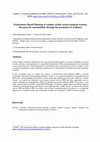
Sustainable Cities and Society, 2021
Urban systems and human settlements have been growing exponentially in size and complexity in the... more Urban systems and human settlements have been growing exponentially in size and complexity in the last decades, defying current approaches to sustainable development. While urban planning has been identified as one of the main tools for attaining specific sustainability goals, consideration of cities as complex socialecological and adaptive systems challenges traditional views, demanding new flexible and creative planning solutions. In this conceptual study, we analyse the capacity of performance-based planning (PBP) to provide sustainable solutions for urban planning problems. To do so, we examine the different conceptualizations of PBP in the current planning environment. To better define the challenges posed by the complexity of urban systems, we explore the similarities and common ground between PBP and other approaches such as adaptive planning and management (APM) and problem structuring methods (PSM). We analyse a case study, in Queensland (Australia), using SWOT (Strengths, Weaknesses, Opportunities and Threats) analysis to identify potential advantages and barriers to the implementation of PBP. Finally, we discuss the potential role of APM and PSM in PBP, the utility of an extended conceptualization of resilience as an important reference for its implementation and a potentially stronger role for planners in PBP as decision shapers.

Sustainable Cities and Society
Keywords: Strategic planning Performance-based planning Complex adaptive systems Adaptive plannin... more Keywords: Strategic planning Performance-based planning Complex adaptive systems Adaptive planning and management Problem structuring methods Resilience A B S T R A C T Urban systems and human settlements have been growing exponentially in size and complexity in the last decades, defying current approaches to sustainable development. While urban planning has been identified as one of the main tools for attaining specific sustainability goals, consideration of cities as complex social-ecological and adaptive systems challenges traditional views, demanding new flexible and creative planning solutions. In this conceptual study, we analyse the capacity of performance-based planning (PBP) to provide sustainable solutions for urban planning problems. To do so, we examine the different conceptualizations of PBP in the current planning environment. To better define the challenges posed by the complexity of urban systems, we explore the similarities and common ground between PBP and other approaches such as adaptive planning and management (APM) and problem structuring methods (PSM). We analyse a case study, in Queensland (Australia), using SWOT (Strengths, Weaknesses, Opportunities and Threats) analysis to identify potential advantages and barriers to the implementation of PBP. Finally, we discuss the potential role of APM and PSM in PBP, the utility of an extended conceptualization of resilience as an important reference for its implementation and a potentially stronger role for planners in PBP as decision shapers.
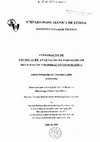
Landscape is being transformed at an accelerated rate in developed countries, due also to an inte... more Landscape is being transformed at an accelerated rate in developed countries, due also to an intense exploitation of natural resources. Among human activities, mining constitutes an important source of environmental impact. Landscape description and evaluation, visual impact assessment and the definition of reclamation and conservation priorities are important to assist decision-making processes. To prevent and minimise environmental degradation, it is important to enable natural resource planners and managers with appropriate tools regarding site selection for future activities, among other environmental concerns. What it concerns to landscape impacts, it is important to evaluate the territory suitability to locate activities that constitute visual intrusions, such as mining activities in order to minimise visual impacts. In the thesis introduction I discuss the concepts of landscape, ecosystem, geosystem, and its interrelationships. In this context I address the dual perspective o...











Uploads
Papers by André Botequilha-Leitão
The second section provides for a case-study focusing on land use change (1990-2000), based on Corine Land Cover data, of a peri-urban landscape in the region of the Algarve (southern Portugal) including four urban areas: Faro, Loulé, Olhão and S. Braz de Alportel. Following ESDP guidelines the newly approved Regional Plan for the Algarve (PROTAL) for the urban system proposes for this landscape to evolve towards a polycentric urban agglomeration. The hinterland located between the four urban areas should, in our perspective, assure a multifunctional character, providing for production (agriculture mainly), recreation opportunities, protection of the fundamental ecological systems, and the landscape quality overall. If these functions are to be assured, we should be proactive.
New challenges for LUP in Portugal emerged within ESDP and LUPS contexts, continuing urban sprawl and the new paradigm on energy and its effects on urban planning and design. Accordingly the third section explores emergent paradigms in land use planning, urbanism, landscape architecture and related disciplines to address these new challenges posed either by PROTAL’ proposals for a urban polycentric system, the need of extending traditional scope of city planning in built areas to include the outer landscape, or the need of alternative urban planning strategies to counteract for urban sprawl, and or simultaneously promote concentration of built-areas and allow for multifunction cities and metropolis.